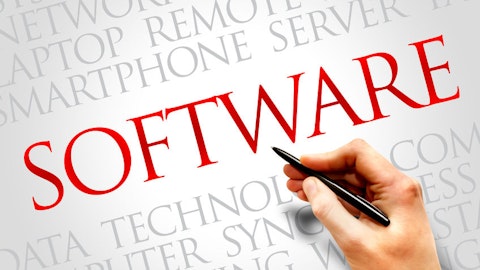Stefan Ortmanns: Maybe let me tackle it first Tom and then you will comment on the words. So we have made a strategic move compared to last year’s Investor Day where we said, okay, we are focused on also on other organic opportunities. We strongly believe focusing on generative AI and large language models will have a higher return of investment in the future. For FY ‘24, we have picked in the opportunities with respect to generative AI, but not in the outer years, right. Then we have the Toyota case and then also what Rich mentioned, right, we have reduced also the prepayments from $40 million to $20 million for the upcoming years. Tom, please.
Tom Beaudoin: Yeah, Stefan. I think you covered it well. So I think it really is those three drivers, right? A refocus and really alignment to our opportunities that we feel, as Nils talked about and Stefan and therefore, a little bit lower revenues from some of those adjacency technologies that we think are better served through partnerships. And then, of course, the effect of the legacy pull-in and what we think is the right thing for the business which is the lower prepaid amounts.
Colin Langan: And any examples of what you’re not targeting now for the market opportunities that you’re sort of letting go to out to partners, I guess?
Stefan Ortmanns: Well, I think if you remember in the investor presentation there were some adjacent activities in supplying some data and information that’s our core to the three product strategies that Nils laid out and I think we’re just refocusing our investments on the core. Is there anything you can add to that, Nils?
Nils Schanz: No, exactly. I mean we have presented back in the time a couple of initiatives, right, that we wanted to expand, for instance in the biometrics field and there we have shifted now some of these programs more to the LLM-based architecture and really upgrading our portfolio with generative AI. That is the full focus.
Colin Langan: Got it. And just lastly, with the new change on fixed contracts down to 20, when should we think of that sort of consumption versus revenue stabilizing? Is that now like a 2026 timeframe where those kind of even out?
Nils Schanz: Colin, that’s correct.
Colin Langan: Okay. All right. Thanks for taking the questions.
Operator: Thank you. Our next question comes from Quinn Bolton with Needham. Your line is open.
Quinn Bolton: Hey, guys. Thanks for letting me ask a question. First, I just wanted to clarify the decline in the connected backlog. Is that due entirely to the Toyota Legacy coming out of that figure?
Stefan Ortmanns: Yeah. That’s mostly. As you can see from some of the other metrics that we provided, the connected services across the billings has been growing quite well, even the new connected services have been growing in the last few quarters. And then as we stated, I think if you look at our deferred revenue, historically and on a go-forward basis, It’s the kind of best indicator of the future revenue growth, which lags a little bit due to the amortization schedule. But Connected Services, I think, is performing right well and we think it’s going to be a big growth driver going forward.
Quinn Bolton: Got it. And the second question I had is, I think last quarter you talked about the push out of some of the SOPs delaying some of the higher priced offerings, kind of wondering, you’ve mentioned a couple of times connected services seeing a delayed effect because of the amortization. I mean can you give us sort of your outlook just how you’re looking at pricing per vehicle as you move into fiscal ‘24 and perhaps beyond?
Stefan Ortmanns: Yeah. Okay. Go ahead. Tom, please go ahead.
Tom Beaudoin: So we’re continuing to see good PPU growth across. Some of those delayed SOPs have been factored into the ‘24 guidance and the updated multi-year plan there. But on a total basis, it is an average across our — high penetration across all the OEMs wherein some OEMs, they start with a couple of our solutions at a lower PPU. It’s a bit of why we think moving to total billings growth is a better indicator of us continuing to be the preferred supplier in the market and the growth in billings and revenue that will come from that. So the products that Nils talked about all carry a pretty high PPU across them.
Stefan Ortmanns: Yeah. So maybe what we can say here is actually three factors. So first of all, we have high visibility into our OEMs, SOPs, right? Special thanks also to Niels, because he’s also driving professional services across the globe. Secondly, for new programs, we see, indeed, a higher PPU across embedded and cloud. And thirdly, what Nils also mentioned is now we have opportunities for upselling, meaning bringing new innovations on SOP cars, meaning cars on the road.
Quinn Bolton: Yeah. And that was giving my sort of second or perhaps third question was just, you talked a lot about the new software offerings around LLMs and generative AI, the first of which goes into production in the calendar first quarter. Can you talk, how does that affect PPU? I would assume that that probably comes in as a pretty good PPU as you deliver those software, but wondering if you might be able to provide sort of any additional color on how you’re thinking about pricing the new AI and LLM offerings. Thank you.
Stefan Ortmanns: We cannot share everything here for sure. But you will see a big announcement during CES with one of the largest car makers worldwide. We are addressing already SOP cars but also new programs with our new LLM based architecture. Nils additional comments from your side?



